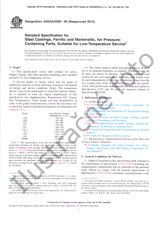Potrebujeme váš súhlas na využitie jednotlivých dát, aby sa vám okrem iného mohli ukazovať informácie týkajúce sa vašich záujmov. Súhlas udelíte kliknutím na tlačidlo „OK“.
ASTM D8387/D8387M-21
Standard Test Method for High Bypass – Low Bearing Interaction Response of Polymer Matrix Composite Laminates
NORMA vydaná dňa 1.4.2021
Informácie o norme:
Označenie normy: ASTM D8387/D8387M-21
Poznámka: NEPLATNÁ
Dátum vydania normy: 1.4.2021
Kód tovaru: NS-1029219
Počet strán: 29
Približná hmotnosť: 87 g (0.19 libier)
Krajina: Americká technická norma
Kategória: Technické normy ASTM
Anotácia textu normy ASTM D8387/D8387M-21 :
Keywords:
bearing/bypass properties, bearing strength, bypass strength, composite materials,, ICS Number Code 83.120 (Reinforced plastics),83.140.20 (Laminated sheets)
Doplňujúce informácie
| Significance and Use |
|
5.1?This test method is designed to produce low bearing / high bypass interaction response data for research and development, and for structural design and analysis. The standard configuration for this procedure is very specific and is intended as a baseline configuration for developing structural design data. The high bypass/low bearing double-shear hardpoint configuration is recommended for determining the effect of low bearing stress levels on bypass strength. While a similar single-shear configuration could be tested, there is insufficient experience with a single-shear configuration to recommend its use at this time. 5.2?General factors that influence the mechanical response of composite laminates and should therefore be reported include the following: material, methods of material preparation and lay-up, specimen stacking sequence, specimen preparation, specimen conditioning, environment of testing, specimen alignment and gripping, speed of testing, time held at test temperature, void content, and volume percent reinforcement. 5.3?Specific factors that influence the bearing/bypass interaction response of composite laminates and should therefore be reported include not only loading type (tension or compression) but the following: edge distance ratio, width to diameter ratio, diameter to thickness ratio, fastener torque, fastener or pin material, fastener or pin clearance. Properties, in the test direction, which may be obtained from this test method include the following: 5.3.1?Filled hole tensile bearing/bypass strength. 5.3.2?Filled hole compressive bearing/bypass strength. 5.3.3?Bearing stress/bypass strain curve. |
| 1. Scope |
|
1.1?This test method determines the uniaxial high bypass - low bearing interaction response of multi-directional polymer matrix composite laminates reinforced by high-modulus fibers using a two-fastener hard point joint specimen. The scope of this test method is limited to net section (bypass) failure modes. Standard specimen configurations using fixed values of test parameters are described for this procedure. A number of test parameters may be varied within the scope of the standard, provided that the parameters are fully documented in the test report. The composite material forms are limited to continuous-fiber or discontinuous-fiber (tape or fabric, or both) reinforced composites for which the laminate is balanced and symmetric with respect to the test direction. The range of acceptable test laminates and thicknesses are described in 8.2.1. This test method was previously published under Test Method D7248/D7248M-17 Procedure C. 1.2?This test method is consistent with the recommendations of Composite Materials Handbook, CMH-17, which describes the desirable attributes of a bearing/bypass interaction response test method. 1.3?The two-fastener test configurations described in this test method are intended to provide data in the relatively high bypass, low bearing part of the composite bolted joint bearing-bypass interaction diagram. This data complements the data from filled hole tension and compression (Practice D6742/D6742M), bearing (Test Method D5961/D5961M), and low bypass/high bearing interaction (Test Method D7248/D7248M) tests. 1.4?This test method requires careful specimen design, instrumentation, data measurement, and data analysis. The use of this test method requires close coordination between the test requestor and the test lab personnel. Test requestors need to be familiar with the data analysis procedures of this test method and should not expect test labs who are unfamiliar with this test method to be able to produce acceptable results without close coordination. 1.5?UnitsThe values stated in either SI units or inch-pound units are to be regarded separately as standard. The values stated in each system are not necessarily exact equivalents; therefore, to ensure conformance with the standard, each system shall be used independently of the other, and values from the two systems shall not be combined. 1.5.1?Within the text, the inch-pound units are shown in brackets. 1.6?This standard does not purport to address all of the safety concerns, if any, associated with its use. It is the responsibility of the user of this standard to establish appropriate safety, health, and environmental practices and determine the applicability of regulatory limitations prior to use. 1.7?This international standard was developed in accordance with internationally recognized principles on standardization established in the Decision on Principles for the Development of International Standards, Guides and Recommendations issued by the World Trade Organization Technical Barriers to Trade (TBT) Committee. |
Odporúčame:
Aktualizácia technických noriem
Chcete mať istotu, že používate len platné technické normy?
Ponúkame Vám riešenie, ktoré Vám zaistí mesačný prehľad o aktuálnosti noriem, ktoré používate.
Chcete vedieť viac informácií ? Pozrite sa na túto stránku.




 Cookies
Cookies
